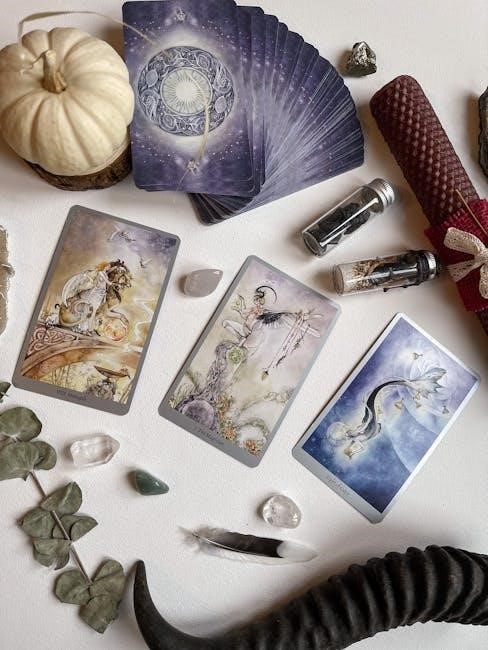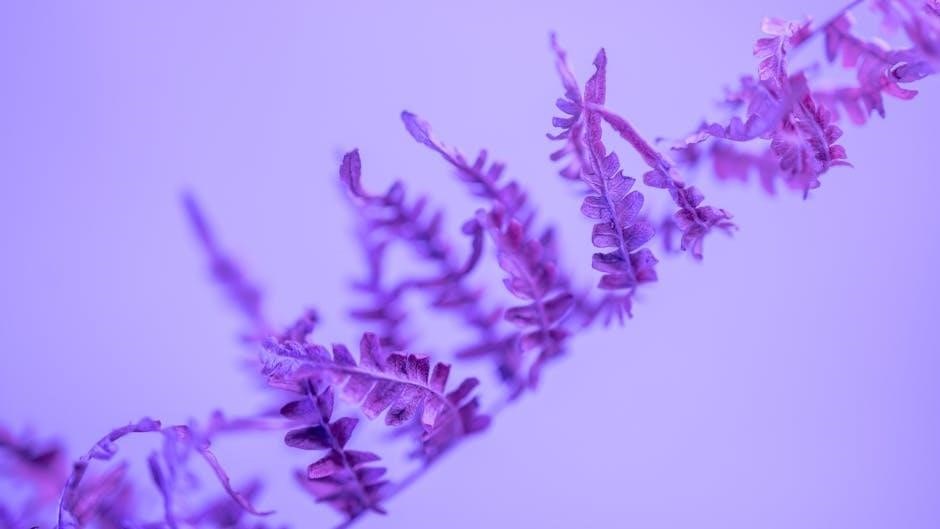
Scott Cunningham’s Encyclopedia of Magical Herbs is a comprehensive guide to over 400 herbs, detailing their magical properties, historical uses, and practical applications for natural magic.
Overview of the Book
Scott Cunningham’s Encyclopedia of Magical Herbs is an expanded and revised guide featuring magical uses of over 400 herbs and plants worldwide. It offers detailed descriptions of each herb’s properties, historical significance, and practical applications for spells and rituals. Designed for natural magic practitioners, this comprehensive resource includes illustrations for easy identification, making it accessible to both beginners and experienced herbalists. With over 400,000 copies in print, it remains a must-have reference for those seeking to explore the power of magical herbalism in contemporary witchcraft and natural magic practices.
Importance of Magical Herbs in Modern Practice
Magical herbs play a vital role in modern witchcraft, offering a bridge between ancient traditions and contemporary practices. Their versatility in spells, rituals, and talismans makes them indispensable for practitioners seeking to harness nature’s power. With a growing interest in natural and sustainable magic, herbs provide a practical and ethical way to connect with the earth and amplify magical intentions. Cunningham’s work highlights their significance, empowering modern witches to integrate herbal magic into daily life, fostering a deeper appreciation for the natural world and its spiritual potential.

Scott Cunningham and His Contributions
Scott Cunningham’s pioneering work in magical herbalism has made him a revered figure, offering a wealth of knowledge through his comprehensive guides on herb magic and their practical applications.
Biography of Scott Cunningham
Scott Cunningham was a prominent figure in modern Witchcraft and herbalism, best known for his extensive contributions to magical herbalism. Born with a deep connection to nature, Cunningham’s work laid the foundation for contemporary herbal practices, blending folklore, magic, and practical applications. His books, including Encyclopedia of Magical Herbs, have become essential resources for practitioners worldwide, offering detailed insights into the properties and uses of various herbs. His legacy continues to inspire those exploring the mystical and practical aspects of plant magic.
His Role in Popularizing Magical Herbalism
Scott Cunningham played a pivotal role in popularizing magical herbalism through his accessible and comprehensive writings. His works, particularly Encyclopedia of Magical Herbs, demystified herb magic, making it approachable for practitioners of all levels. By blending folklore, historical uses, and practical applications, Cunningham empowered individuals to integrate herbalism into daily magical practices. His books, with over 400,000 copies in print, became foundational texts, inspiring a wide audience to explore the potential of plants in spells, rituals, and natural magic, thus leaving a lasting legacy in the field of magical herbalism.

Structure and Content of the Encyclopedia
Encyclopedia of Magical Herbs is a comprehensive guide featuring detailed descriptions of over 400 herbs, their magical attributes, historical uses, and practical applications, enhanced with illustrations.
Comprehensive List of Herbs and Their Properties
The Encyclopedia of Magical Herbs provides an extensive catalog of over 400 herbs, each detailed with their magical attributes, historical uses, and practical applications. Entries include common names, rulership, and folklore, while illustrations aid in plant identification. This comprehensive guide is essential for natural magic practitioners, offering insights into herb magic and their role in spells and rituals. The detailed descriptions empower users to harness the full potential of these natural gifts, making it a vital resource for anyone exploring magical herbalism.
Historical and Cultural Significance of Magical Herbs
The Encyclopedia of Magical Herbs delves into the rich historical and cultural significance of herbs, exploring their role in ancient rituals, myths, and folklore. It highlights how herbs have been revered across civilizations for their magical and symbolic meanings. From their use in sacred ceremonies to their association with deities, the book provides a fascinating glimpse into the timeless connection between plants and human spirituality. This historical perspective enriches modern practitioners’ understanding, bridging the past with contemporary magical practices. The text underscores the enduring importance of herbs in shaping cultural and spiritual traditions worldwide.

Magical Herbs in History
Magical herbs have been integral to ancient cultures, featuring prominently in rituals, spells, and spiritual practices. Historical records reveal their use in Egyptian, Greek, and Celtic traditions.
Folklore and Mythology Surrounding Herbs
Herbs have long been steeped in folklore and mythology, with many cultures attributing magical and spiritual powers to them. Ancient myths often depicted herbs as gifts from deities, imbued with divine energy. For instance, the Greeks associated certain plants with their gods, while Celtic traditions linked herbs to sacred rituals and druidic practices. These stories have shaped the cultural and magical significance of herbs, influencing their use in spells, talismans, and spiritual ceremonies. The folklore surrounding herbs continues to inspire modern practitioners, bridging the gap between ancient beliefs and contemporary magical practices.
Historical Uses of Herbs in Magic and Rituals
Herbs have been integral to magical rituals across centuries, with ancient civilizations employing them for protection, healing, and divination. In Egyptian rituals, specific herbs were burned to purify spaces and honor deities. Similarly, European folklore details the use of herbs in protective spells and potions. Many cultures believed herbs held sacred powers, connecting the physical and spiritual realms. These historical practices laid the foundation for modern herbal magic, emphasizing the importance of intention and reverence when using plants in rituals. The legacy of these ancient traditions continues to inspire contemporary practitioners of natural magic and herbalism.

Properties of Magical Herbs
Magical herbs possess unique attributes, blending medicinal properties with mystical energies. Cunningham’s work details planetary associations, elemental alignments, and practical applications, guiding practitioners in harnessing their full potential effectively.
Magical Attributes vs. Medicinal Properties
While magical herbs are often celebrated for their mystical attributes, such as enhancing spells or attracting positive energies, they also possess medicinal properties. For instance, chamomile is known for its calming effects in both magical rituals and herbal teas. Cunningham’s encyclopedia highlights this duality, providing a detailed understanding of how herbs like sage and lavender can be used for healing as well as for purification and protection. This dual nature makes herbs versatile tools in both natural medicine and magical practices, offering practitioners a holistic approach to wellness and spirituality. By exploring both aspects, users can maximize the benefits of these natural gifts.
Understanding Herb correspondences
Understanding Herb Correspondences
Herb correspondences refer to the associations between specific herbs and various magical elements, such as planets, zodiac signs, colors, and energies. For example, lavender is linked to the planet Mercury and the element of air, enhancing clarity and communication in spells. These correspondences help practitioners align their magical intentions with the natural properties of herbs. By understanding these connections, users can create more effective and targeted spells, ensuring their rituals resonate with the desired energies. Cunningham’s encyclopedia provides detailed tables and explanations, making it easier to harness the full potential of herb magic in a structured and meaningful way.

Using Herbs in Spells and Rituals
Herbs enhance spells by aligning energies with magical intentions, offering practical uses for protection, healing, and prosperity. Cunningham’s guide provides detailed methods for effective rituals.
Practical Applications of Herb Magic
Herb magic offers versatile and practical uses in spells, rituals, and daily life. From protection to healing, herbs can be infused, burned, or carried to manifest specific intentions. Scott Cunningham’s guide details how to harness these natural gifts effectively, ensuring anyone can incorporate herb magic into their practice. Whether for talismans, potions, or rituals, the encyclopedia provides clear, actionable methods to enhance magical workings with the inherent power of plants.
Creating Effective Herbal Spells
Creating effective herbal spells involves aligning herbs with specific magical intentions. Cunningham’s guide emphasizes the importance of intention, preparation, and execution. By selecting herbs that match the spell’s purpose, practitioners can enhance their magical outcomes. Timing, lunar phases, and the herb’s natural energies also play crucial roles. The encyclopedia provides practical tips for crafting spells, ensuring a harmonious blend of nature and magic. This approach empowers individuals to create meaningful and potent rituals, making herb magic accessible and impactful for all levels of practitioners.

Herbs and Their Magical Correspondences
The encyclopedia explores herbs’ magical correspondences, including planetary and elemental associations, to enhance spell effectiveness and align with nature’s hidden energies.
Planetary and Elemental Associations
The encyclopedia details how herbs align with planets and elements, such as Mercury for communication or Earth for stability. These associations guide practitioners in selecting herbs that resonate with specific magical goals, enhancing spellcasting. For instance, lavender, linked to the Moon, is ideal for intuition, while Mars-associated garlic boosts protection. Understanding these correspondences allows for precise energy alignment, ensuring rituals are more effective. This section bridges ancient astrological and elemental wisdom with modern herbal magic, offering a deeper connection to nature’s forces and their role in spellwork.
Colors, Scents, and Energies of Herbs
Herbs possess distinct colors, scents, and energies that influence their magical properties. Brightly colored herbs like red clover symbolize vitality, while calming scents such as chamomile promote relaxation. The energy of each herb—whether calming, stimulating, or grounding—plays a crucial role in spellcasting. Cunningham explains how these traits can be harnessed to enhance rituals, ensuring alignment with the desired magical outcome. This section emphasizes the sensory and vibrational aspects of herbs, offering practical insights for practitioners to deepen their connection with nature’s magical tools and create more effective, intention-driven spells.

Growing and Cultivating Magical Herbs
Cultivating magical herbs requires attention to soil quality, sunlight, and watering. Ethical practices, like organic methods, ensure herbs retain their potent energies for spellwork and rituals.
Best Practices for Herb Gardening
Successful herb gardening begins with well-drained soil and adequate sunlight. Most herbs thrive in full sun and fertile ground. Water deeply but avoid overwatering to prevent root rot; Fertilize sparingly, as excessive nutrients can dilute magical properties. Prune regularly to encourage healthy growth and prevent pests. Plant herbs during the waxing moon for robust energy. Consider companion planting to enhance growth and magical synergy. Use organic methods to maintain the herbs’ natural potency. Harvest during the morning for peak energy, and store dried herbs in airtight containers to preserve their properties for spellwork and rituals.
Harvesting and Storing Herbs for Magic
Herbs for magic should be harvested during the waxing moon to capture their peak energy. Pinch or cut leaves and flowers at dawn, when dew is present, to retain their essence. For roots and bark, harvest during the full moon. Dry herbs immediately in a cool, dark place or tie in small bunches to air-dry. Store in airtight containers to preserve potency, labeling each with its name and magical properties. Keep them away from direct sunlight and negative energies to maintain their effectiveness for spells and rituals.
Magical Herbs Across Cultures
Herbal magic varies globally, with traditions like African, Asian, and European practices emphasizing unique cultural uses, rituals, and symbolic meanings of plants in spellcraft and spirituality.
Herbal Magic in Different Traditions
Herbal magic varies widely across cultures, reflecting diverse beliefs and practices. In European folk magic, herbs are often used for protection and healing, while Asian traditions emphasize their spiritual and medicinal properties. African diasporic practices incorporate herbs into rituals for prosperity and purification; Similarly, Native American rituals utilize plants for ceremonies and communal harmony. Each tradition highlights unique methods of harnessing herb magic, showcasing the global significance of plants in spellcraft and spirituality. Cunningham’s encyclopedia bridges these traditions, offering insights into their shared and distinct practices.
Global Variations in Herb Use
Herbal practices vary significantly across the globe, reflecting cultural and regional diversity. In Europe, herbs like sage and lavender are used for purification, while Asian traditions favor ginseng and ginger for energy. African cultures utilize plants like yarrow for protection, and in the Americas, native species such as sweetgrass are burned for cleansing; These variations highlight the adaptability of herbal magic to local flora and spiritual systems. Cunningham’s work catalogues these global differences, offering a rich tapestry of traditions that emphasize the universal appeal of herb magic in diverse cultural contexts.
The Encyclopedia as a Practical Guide
Cunningham’s Encyclopedia serves as an essential tool for daily magical practice, offering practical insights and step-by-step guidance for effectively incorporating herbs into spells and rituals.
Using the Book for Daily Magical Practice
The Encyclopedia of Magical Herbs is a vital resource for practitioners seeking to integrate herbal magic into their daily routines. It provides detailed instructions for crafting spells, creating talismans, and using herbs in rituals. Each entry includes practical tips, allowing users to apply the herbs’ magical properties effectively. Whether for protection, healing, or prosperity, the guide offers accessible methods to enhance magical practices. This makes it an indispensable companion for witches and herbalists aiming to deepen their craft and connect with nature’s power. Its clear and concise approach ensures that both beginners and advanced practitioners can benefit from its wealth of knowledge.
Case Studies and Examples
The Encyclopedia of Magical Herbs includes real-life case studies and examples to illustrate the practical application of herb magic. Readers learn how to create effective spells using specific herbs, such as chamomile for calm or lavender for clarity. Detailed examples demonstrate how to craft rituals for protection, healing, or prosperity. For instance, sage is highlighted for purification, while basil is suggested for prosperity spells. These examples provide a clear framework for practitioners to experiment and adapt the techniques to their unique needs, making the book a hands-on guide for meaningful magical practice.

Modern Relevance of Magical Herbalism
Magical herbalism remains highly relevant today, blending ancient traditions with modern accessibility through digital resources like Encyclopedia of Magical Herbs, making natural magic accessible worldwide.
Herb Magic in Contemporary Witchcraft
Herb magic has become a cornerstone of contemporary witchcraft, offering a tangible connection to nature and ancient traditions. Encyclopedia of Magical Herbs highlights the practical applications of over 400 herbs, making it a vital resource for modern practitioners. Many witches today incorporate herbs into spells, rituals, and talismans, leveraging their magical properties for protection, healing, and divination. The resurgence of interest in natural magic has led to a growing community of practitioners who value the simplicity and potency of herb-based rituals. This approach to witchcraft emphasizes harmony with the environment and the innate power of plants.
The Growing Interest in Natural Magic
The growing interest in natural magic has led to a resurgence in the study and use of magical herbs. Encyclopedia of Magical Herbs has become a cornerstone for practitioners seeking to connect with nature and harness its power. As modern society increasingly values sustainability and holistic practices, herb magic offers a practical and ethical way to engage with the environment. This shift reflects a broader desire to return to ancient, earth-centered traditions, making Cunningham’s work a vital resource for those exploring the intersection of nature and spirituality.

Ethical Considerations in Herb Magic
Herb magic emphasizes responsible use, ensuring sustainability and minimizing environmental harm. Practitioners must respect nature’s balance and avoid over-harvesting, fostering a harmonious connection with the earth.
Responsible Use of Herbs
Responsible herb use is vital for ethical magical practice. Harvesting should be done sustainably, ensuring plant survival and ecosystem balance. Practitioners must respect wild herbs, avoiding over-harvesting and prioritizing cultivation. Ethical sourcing is key; avoid plants endangered or illegally traded. Gratitude and respect for nature’s gifts are encouraged, fostering harmony with the earth. Cunningham’s guide emphasizes mindful practices, ensuring herbs are used wisely for magic and rituals without harming the environment or depleting natural resources, promoting a sustainable future for herb magic.
Sustainability and Environmental Impact
Sustainability is crucial in herb magic to preserve ecosystems and ensure future availability. Practitioners should adopt eco-conscious practices, such as cultivating herbs rather than wild-harvesting. Over-harvesting threatens plant populations and disrupts biodiversity. Ethical sourcing, including buying from sustainable suppliers, supports environmental conservation. Cunningham’s work emphasizes the importance of responsible stewardship and the need to minimize ecological footprint. By prioritizing sustainable practices, herbalists can protect the planet while harnessing the magical potential of herbs, ensuring their availability for generations to come.
Resources for Further Study
Explore online communities, forums, and libraries like Project Gutenberg and Open Library for free PDF downloads of Cunningham’s Encyclopedia and related magical herbalism texts.
Recommended Reading and References
For deeper exploration, readers can access Cunningham’s Encyclopedia of Magical Herbs via platforms like Project Gutenberg and Open Library, offering free PDF downloads. Additional resources include The Complete Illustrated Encyclopedia of Magical Plants and Bartram’s Encyclopedia of Herbal Medicine. Online communities and forums, such as Internet Archive and Libgen, provide extensive libraries for magical herbalism. These references are available in formats like ePub, MOBI, and CHM, ensuring accessibility for all readers. Utilize download managers like JDownloader for seamless access to these invaluable texts.
Online Communities and Forums
Online communities and forums dedicated to magical herbalism offer vibrant spaces for enthusiasts to connect and share knowledge. Platforms like Reddit’s r/MagicalHerbs, Facebook groups focused on herbal magic, and specialized forums such as WitchVox provide arenas for discussion. Members engage in topics ranging from spellcraft to herb cultivation, sharing insights and experiences. These communities often feature expert Q&A sessions and resource exchanges, including downloadable guides and PDF materials. They serve as invaluable hubs for both novices seeking guidance and seasoned practitioners looking to expand and refine their magical herbalism expertise.